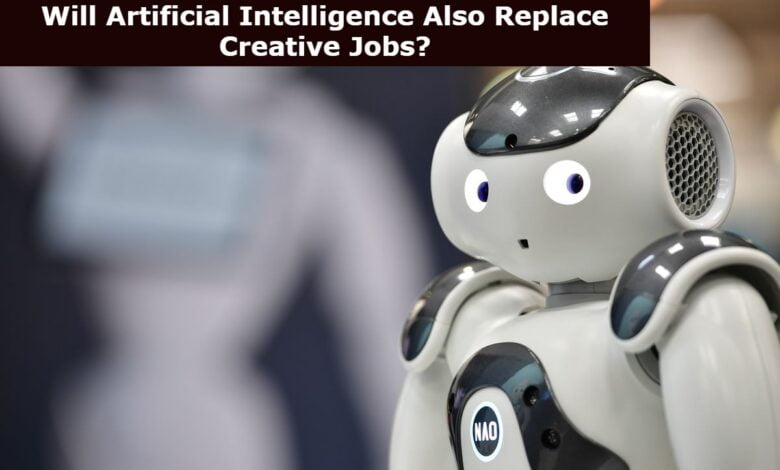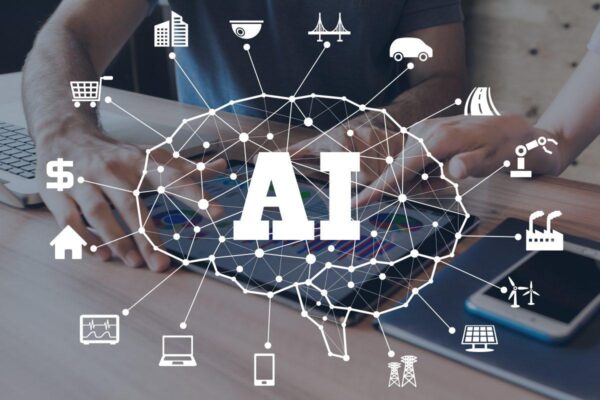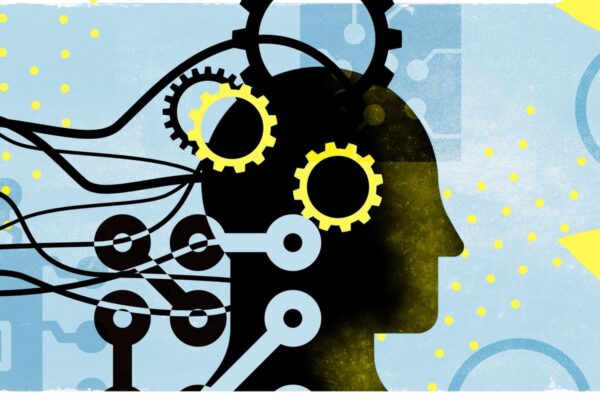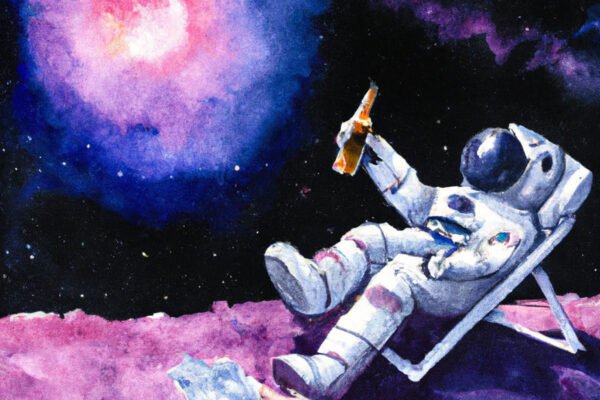Will Artificial Intelligence Also Replace Creative Jobs?

Will Artificial intelligence also replace creative jobs?
Will robots eventually take my job? In the modern economy, this is a frequently asked question. The change has already started, but a 2016 World Economic Forum analysis estimated that by 2020, automation and robotics would cost more than five million jobs.
AI has more significant economic and social ramifications than ever as machines change the workforce.
Advertising and other creative sectors were forced to question if the formerly thought-unique to the human brain creative process would soon be automated by machines. Is AI able to become the inspiration for fresh concepts?
We must first come to a concept of creativity that is universally accepted to settle the argument over whether AI is capable of creativity.
Let’s start this post by defining what creativity is not: Stevan Harnad, a cognitive scientist, claims that simple mental processes like imitation, learning, and induction are not always creative.
If discovering answers requires seeing the world in various ways, then AI is not just creative but also potentially has a higher level of creative intelligence.
For instance, humans still exclusively gather information about their surroundings. In the meantime, machines can integrate a vast amount of data via the internet and produce complete outputs in milliseconds.
Machines digest information at an unimaginable rate and transcend humans’ biological limitations.
Of course, when it comes to our capacity to comprehend sensory data, humans outperform AI. But with substantial investments in computer vision by businesses like Google, AI is starting to accurately assess an object’s qualities similarly to how we rely on our senses to make decisions.
Artificial intelligence, or AI, is the capacity of machines to perform particular activities that often require human intelligence. It makes it possible for the devices to grasp and complete specific tasks. Said, machines independently learn from historical data without human intervention.

Millions of already existing occupations will likely be eliminated by artificial intelligence, while millions of new ones, some of which have not yet been imagined, will be created.
Through deep learning, computers can process enormous volumes of unstructured data, including text, images, and audio.
Four different types of artificial intelligence exist:
- Reactive Machines
- Limited Memory
- Theory of Mind
- Self- Awareness
Artificial intelligence has influenced every aspect of modern life for humans because it is all around us.
- Siri, Alexa and other intelligent assistants
- Self-driving cars
- Robo-advisors
- Conversational bots
- Smart Email Apps
- Search and Recommend Algorithms
- E-Payments
- OTT recommendations
- Social Media
- Music Streaming Services
- Google Maps and Navigation
- Text Editors and Autocorrect
The portion of jobs that AI will replace
Under the World Economic Forum’s “The Future of Jobs Report 2020,” AI will cause the loss of 85 million jobs worldwide by 2025. Despite how terrifying that sounds, the article continues by stating that within the same time, 97 million new employment will be created.
Understanding Artificial Intelligence (AI)
The first thing that comes to most people’s minds when they hear the word artificial intelligence is typically robots. That’s because high-profile movies and books frequently include human-like machines that bring havoc on Earth. But the opposite is true.
Artificial intelligence is founded on the idea that human intelligence can be described in a way that makes it simple for a computer to duplicate and carry out activities of any complexity. Artificial intelligence aims to emulate cognitive processes in humans.
Regarding concretely defining processes like learning, reasoning, and perception, researchers and developers in the field are making unexpectedly quick progress. Some people think that soon inventors might be able to create systems that are better than what humans are currently capable of learning or understanding.
Others are still dubious because all cognitive processes involve value judgments influenced by human experience.
The criteria used to define artificial intelligence in the past are becoming obsolete as technology develops. For instance, machines that perform simple calculations or optical character recognition on text are no longer regarded as embodying artificial intelligence because we now consider these capabilities part of any computer.
AI is constantly developing for the good of numerous sectors. A multidisciplinary approach based on mathematics, computer science, linguistics, psychology, and other fields is used for wiring machines.
How is AI being used today?

With varying degrees of sophistication, AI is currently used widely in various applications. Popular AI implementations include recommendation algorithms that suggest what you might like next and chatbots that can be found on websites or in the form of smart speakers (e.g., Alexa or Siri).
AI is utilized to automate production processes, reduce redundant cognitive labour, and create forecasts for the weather and the economy (e.g., tax accounting or editing). AI is also used to understand language, drive autonomous vehicles, play games, and do many other things.
How is AI applied in healthcare?
AI is utilized in healthcare settings to support diagnoses. AI is excellent at spotting minute irregularities in scans and can more accurately make diagnoses based on a patient’s symptoms and vital signs.
AI is also used to categorize patients, keep track of and preserve medical information, and manage insurance claims. Future technological advancements include collaborative clinical judgment, virtual nurses or doctors, and AI-assisted robotic surgery.
Future Uses of AI
Like the exponential rise of database technology in the late 20th century, AI is developing at a breakneck pace. The value of data has increased due to AI’s voracious appetite for data storage, retention, and analysis.
The term “metaverse” first appeared in the science fiction book “Snow Crash” in 1992. It was seen at the time as being too far in the future and a science fiction idea. But now, less than 30 years later, it is almost a reality.
A single, global, and fully immersive virtual reality is known as the metaverse. Simply put, it is an alternate reality made possible through virtual and augmented reality.
A metaverse is now used in the video game business. This might very well spread to daily life. The metaverse can accommodate any event, including conferences, meetings, weddings, and parties. Its applications are virtually limitless.
Can AI Replace Human Creativity in Creative Jobs?

Humans are attempting to create a system that mimics their intelligence. A starting point is necessary to accomplish this. What is the point of departure? A vast amount of information.
We must first feed a computer with thousands of photographs of tigers and lions if we want it to distinguish between them. Human intelligence, however, is a versatile tool.
A device with the capacity to make choices, produce, learn, grow, be inspired by a lifetime of experiences, feel, empathize, and think in novel ways to fit a square peg into a round hole.
Creativity
Albert Einstein once said, “Creativity is seeing what everyone else sees and thinking what no one else thinks.”
The advertising sector is most likely the best illustration of this. This sector may have made the best use of AI. It has developed campaigns that have won awards.
“The Next Rembrandt” is a fantastic illustration of how AI can be used to its full potential to comprehend the painting technique, use of colour, lighting, topic interest, etc., of the Dutch Master. Then, using all this information, a contemporary painting imitating his style can be created.
But machines can never know whether Rembrandt would have changed or if his interests may have turned to a different type of painting or subject.
Empathy
Understanding the issues and reality of people allows us to build the most incredible product based on those insights. AI can gather and compile facts, but it will never fully understand human motivations.
Data can depict a person’s activity over days or months, but it cannot explain the “why” behind those activities.
This particular human characteristic is what distinguishes us from AI. This characteristic enables people to design and produce goods using more thorough, well-informed judgment.
Mind Theory
A web of emotions permeates the human psyche, influencing both cognition and conduct. AI would need to understand human complexity and make decisions after reflecting on its actions to replace creativity. It is currently beyond the capabilities of AI technology.
Conclusion
Artificial intelligence was created due to the more remarkable intellect possessed by humans. However, it is a system based on pre-existing data, rules, and algorithms.
The system depends on these precise rules and algorithms to process the data that has been provided to it. Can it gather, connect, and process data more quickly than people? I have no doubts. Can it reach the cornerstones of imagination and then go much further? No.
Humans are endowed with intelligence and a natural desire to learn and develop. Strive to exceed limitations. Continuously change. A tool called artificial intelligence was created to help us on our path to excellence. Neither more nor less. We developed AI as a convenience to help us maintain our level of creative brilliance.
edited and proofread by nikita sharma




